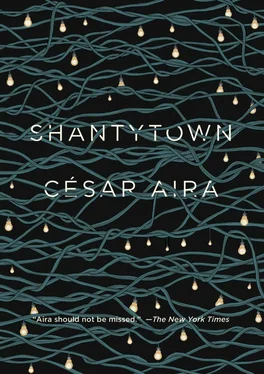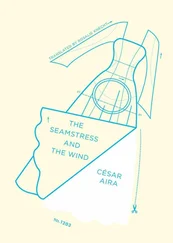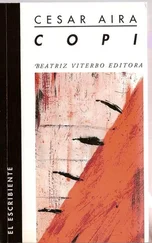There was another aspect of the layout that didn’t conform to rational geometry, and that was the angle of the streets. If the overall shape of the shantytown was circular, then the streets should have run perpendicular to the edge, in a radial pattern, all converging at the center. But no: they ran off at an angle of forty-five degrees, all in the same direction (to the right, for someone facing inward). Which meant that none of them led to the center, or came out anywhere. Where did they end? Maxi never found out. His own incursions were limited to the outer rim; he went as far as the dwelling of the family he happened to be helping, but that was never more than a hundred yards in, always within sight of the perimeter. And since there were no cross streets, he had to go back out the same way. So the center, if indeed there was a center, remained a mystery to him. By the time he reached the shantytown it always seemed too late to ask about it, and he was too shy anyway. For some reason, the lighting, so lavish around the edge, diminished in intensity as one went further in, and toward the center the shantytown seemed to be quite dark. From this it might have been supposed that the middle was empty, but no: the density of settlement increased, the little streets became narrower and the shacks more tightly packed, although it was hard to see far. Even someone with good night vision would have found it difficult because the streets weren’t exactly straight. As for Maxi, half asleep and practically blind (passing under the crown of light always left him dazzled), he would keep looking up and peering ahead as he hauled his load, and whether he was imagining things or misinterpreting what he saw, far off, on the way to the inaccessible center, he thought he could make out towers, domes, phantasmagoric castles, ramparts, pyramids, and groves.
Another thing that he had noticed was the abundance and variety of dogs: aloof, skinny, and mostly quite big. Luckily he wasn’t one of those people who is afraid of dogs. Despite the late hour, they were out and about: rarely alone and sometimes in large packs, they came and went and slipped in everywhere, even running between his legs, or between the wheels of the cart. They were after food, presumably, and since it was so scarce, they had to keep searching night and day. No one paid them any attention or even noticed their existence. But they stayed near the edge, either outside the perimeter or in the first few yards of the little streets. Further in, they were rare, and Maxi never saw one heading for the inner depths or coming back.
If Maxi had been worried (though he never was, not even for a moment) that someone he knew might see him with the collectors, he could have set his mind at rest. None of his friends or acquaintances ever saw him. This, perhaps, was partly due to chance, which sometimes chooses the path of abstention and follows it all the way through the intricate labyrinth of possibilities, and partly due to one of those blind spots that are so typical of big-city life. Not that he had gone completely unnoticed: someone had seen and recognized him. Only one person, who told no one else. And there was a reason why it should have been this person in particular: he was a policeman.
As I said before, Maxi lived on the corner of Bonorino and Bonifacio. One hundred and fifty feet away, on Calle Bonorino, was Police Station 38, and that’s where Inspector Cabezas worked; he had been appointed to supervise the restructuring after the station had been taken over the previous year and all the senior officers dismissed (a judge had burst in one night, leading a special squad of judicial police, and discovered evidence that suspects were being tortured). Cabezas had completed that assignment a few months back but had continued to use the station, which was now functioning normally, as his personal headquarters. One night he saw Maxi hauling a collector’s cart and recognized him. He’d often seen the kid coming out of the building on the corner and been struck his physique. But he would have recognized him anyway; his memory for faces was prodigious.
Once his curiosity was aroused, Cabezas began to keep an eye on Maxi. Since he didn’t have to account for how he spent his time, he’d go out at night in his car, and was able to find Maxi without too much trouble. Cabezas would watch from a distance, sometimes parking for a while and sitting in the car, sometimes driving around the block, following the progress of the meathead and the scavengers. Before long he had more or less worked out Maxi’s routine. At first he assumed that the kid was helping a particular family but he soon realized his mistake, and that intrigued him even more. On several occasions he followed Maxi into the depths of Lower Flores, to the end of his route, where he said goodbye to the collectors and set off home. A couple of times, late in the afternoon, he sat in his car, waiting for Maxi to step out into the street, then tailed him at a safe distance, keeping out of sight, all the way to the point at which he finally turned back, three or four hours later. The time this took was not an issue. Cabezas didn’t do it every day; usually it was enough for him to catch a distant glimpse of Maxi, and see that he was still at it. Sometimes he let days and even whole weeks go by without checking, but then he returned to his observations. . And that was how he noticed Maxi getting closer to the shantytown. After the onset of winter, he would sometimes go to where Bonorino widened and wait for Maxi to stagger into view, at the end of his shift. One night he saw the boy actually go into the shantytown, which inflamed his curiosity and plunged him deep in thought.
Maxi and Inspector Cabezas were different in every way. In age, for a start. One was just beginning his adult life: he didn’t know what he would do with it, and was always reacting on the basis of that uncertainty. The other had passed the age of fifty and begun his decline: he knew exactly what he’d done with his life, and assumed that the fabric of a man’s destiny is woven by every one of his actions, no matter what his age. That assumption was the source of a deep misunderstanding, which was to have serious consequences. The gulf between the two men was evident in the forms of their respective enterprises, which although superposed were incompatible. Maxi’s was linear, an adventure open to improvisation, like a path disappearing into the distance. The inspector’s enterprise, by contrast, resembled the deciphering of a structure. Policemen, whether or not they are influenced by detective fiction, tend to see things as aspects of a “case.” As soon as Cabezas began to take an interest in Maxi’s comings and goings, they constituted a case in his mind. Which meant that nothing could be left unexplained, and each explanation would have to be linked to others, to form a system, which in turn would have to be connected to other systems, until the whole of society was covered.
This was not a purely intellectual problem. In fact, Inspector Cabezas was not an intellectual at all. If an explanation was difficult to find, or he couldn’t be bothered looking, he created one. That’s the way he was: a man of action, not a speculative thinker. And how do you “create” an explanation? By pressing on and improvising. In that respect his method did coincide with Maxi’s, but at a different level and with different objectives. To him, “the case of the generous giant” was completely inexplicable, which gave him the widest possible scope for action. He had to create an explanation out of nothing, as it were.
The structure was based on real events: a rash of violence had broken out on the edge of that circular shantytown, known to the police as “the carousel.” And the incidents had taken place precisely where Calle Bonorino widened out, which was also where the police station had once stood, long before. Providing, as ever, for fugitives and delinquents, the drug trade had intensified, raising the level of violence in the shantytowns, partly because of the serious money involved, but also because of the psychological disturbances produced by the drugs themselves. The situation in “the carousel” was particularly acute. And of course (this is where the inspector’s procedure came in) it wasn’t one case but a myriad, all of them interrelated. For instance, the violent trouble spot that was causing anxiety in the neighborhood didn’t lie within the shantytown itself, where no one could be sure what was really going on, but outside, in its “vestibule.”
Читать дальше












